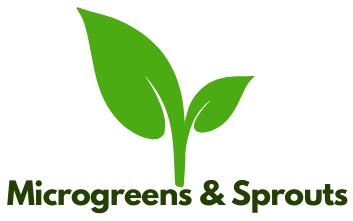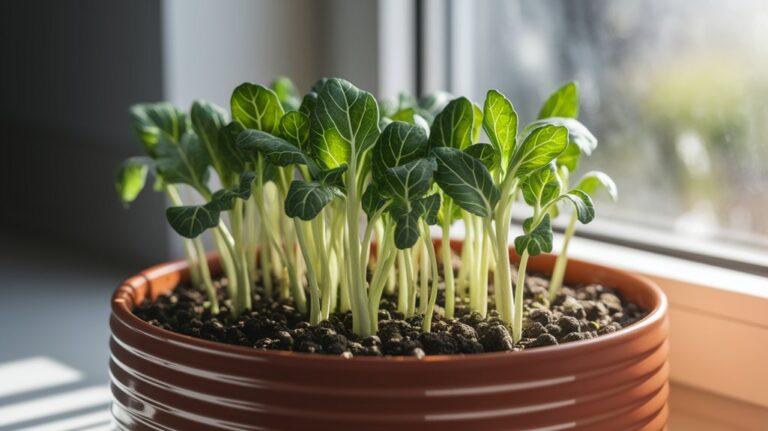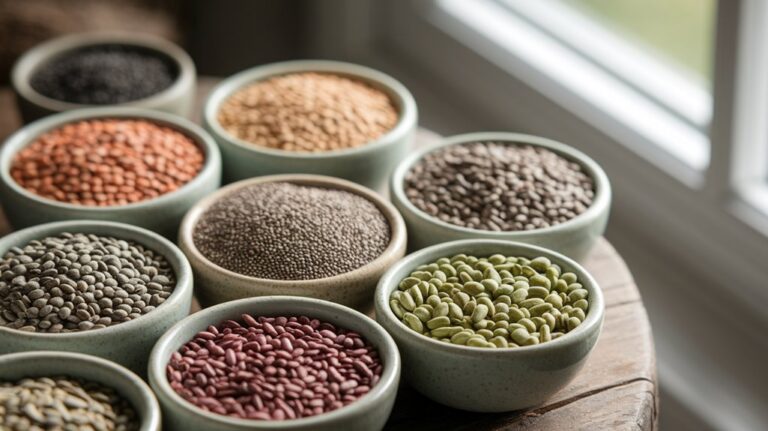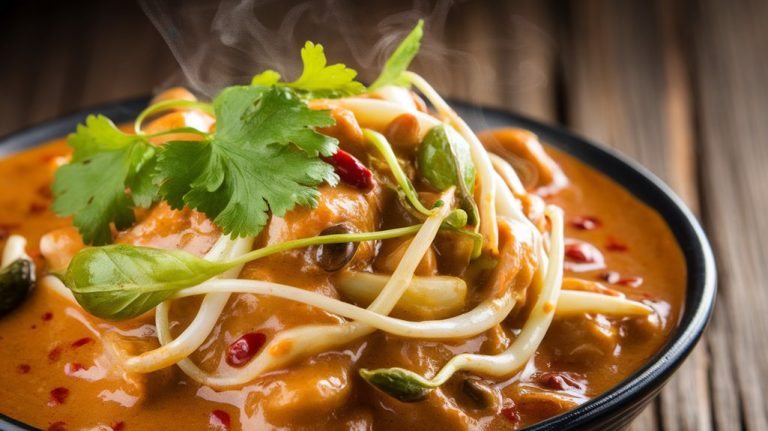How to Sprout Yellow Mustard
To sprout yellow mustard seeds, start by soaking them in water for 6-8 hours. Then, drain and rinse the seeds, spreading them in a sprouting container with good drainage. Mist them 2-3 times a day, ensuring they stay moist but not soggy. Keep the container in a warm (65°F to 75°F) and humid environment with bright, indirect sunlight. Within 7-14 days, you’ll have tasty, nutrient-rich sprouts ready for your meals. To learn about optimal harvesting and culinary uses, keep going!
Key Takeaways
- Soak yellow mustard seeds for 6-8 hours to activate enzymes before draining and rinsing them.
- Use a clean container with good drainage; glass is preferred for monitoring moisture.
- Maintain a temperature of 65°F to 75°F and mist seeds 2-3 times daily to keep them moist.
- Provide bright, indirect sunlight for 12-16 hours daily to promote healthy growth.
- Harvest sprouts when they reach 3-4 inches tall, typically 7-14 days after germination.
Understanding Yellow Mustard Seeds
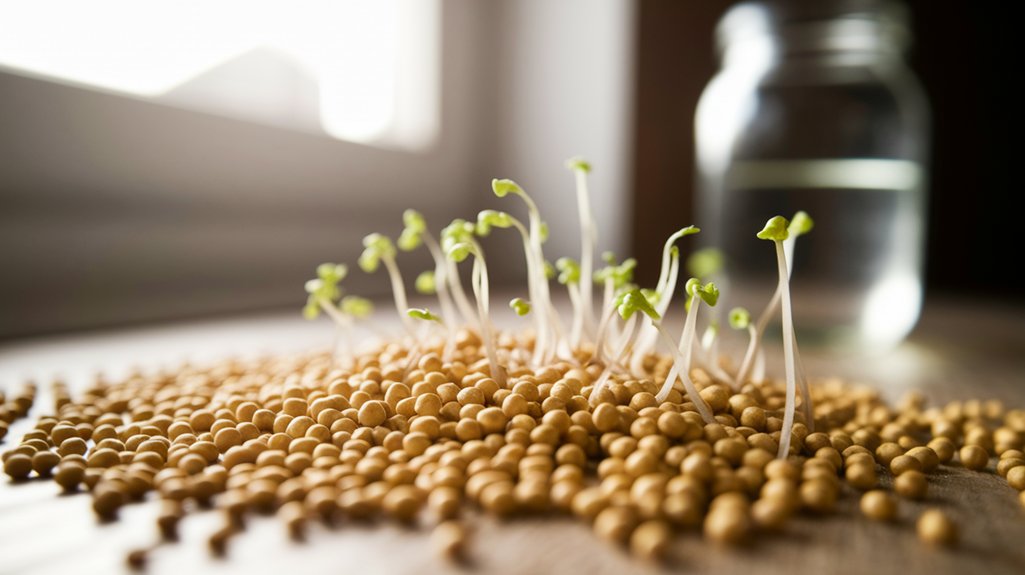
When I think about yellow mustard seeds, I’m reminded of their vibrant color and rich flavor potential. These tiny seeds, scientifically known as Sinapis alba, pack a nutritional punch, being high in protein, fiber, and essential fatty acids.
They’re not just for making mustard; they’re also excellent for sprouting. The sprouting process enhances their health benefits, making nutrients more bioavailable. Typically, yellow mustard seeds germinate within 3 to 5 days under the right conditions.
The sprouts have a mild, peppery flavor, perfect for salads or sandwiches. Their crisp texture adds a delightful crunch. Understanding these seeds’ properties and sprouting potential can transform your culinary experience, elevating both taste and nutrition in your meals.
Choosing the Right Container for Sprouting
When choosing a container for sprouting yellow mustard, I consider the material, size, and drainage needs to ensure optimal growth.
Options like glass, plastic, or ceramic each have their benefits, but I always prioritize good drainage to prevent mold.
A container that’s too small can restrict growth, so I opt for one that allows enough space for the seeds to expand.
Container Material Options
Choosing the right container for sprouting yellow mustard is crucial, as it directly impacts the germination process and overall growth. The material you select can influence moisture retention, airflow, and sanitation.
Here are some options I’ve found effective:
- Glass: Non-porous and easy to clean, glass containers allow you to monitor your sprouts while maintaining moisture levels.
- Plastic: Lightweight and versatile, plastic containers come in various shapes but may require careful monitoring to prevent mold.
- Clay: These provide excellent breathability, but be cautious with moisture retention; they can dry out quickly.
Ultimately, the material you choose should align with your sprouting goals, ensuring a successful growth experience.
Size and Drainage Needs
The right size and drainage capabilities of your container play a pivotal role in sprouting yellow mustard successfully. I’ve found that a container around 6-8 inches deep with good drainage holes works best. You want enough space for roots to grow without waterlogging, which can lead to mold.
Here’s a quick reference table for your container options:
| Container Type | Size Recommendation | Drainage Needs |
|---|---|---|
| Plastic Pots | 6-8 inches deep | Essential holes |
| Glass Jars | 6-8 inches tall | Ensure airflow |
| Seed Trays | 1-2 inches deep | Multiple holes |
| Mesh Containers | 6-10 inches deep | High drainage |
Choosing wisely will set you on the path to delicious sprouts!
Preparing the Seeds for Sprouting
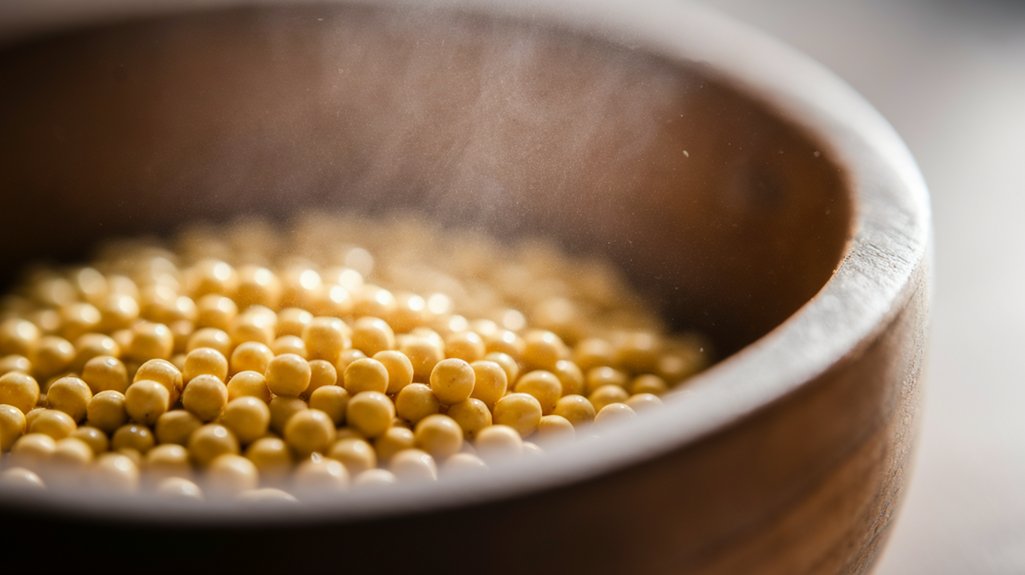
To get started with sprouting yellow mustard, I always emphasize the importance of selecting quality seeds.
Once I’ve chosen the best seeds, I move on to the soaking process, which is crucial for kickstarting germination.
Let’s explore how these two steps set the foundation for successful sprouting.
Selecting Quality Seeds
Quality seeds lay the foundation for successful sprouting, especially when it comes to yellow mustard. I always prioritize selecting seeds that are fresh, viable, and suited for sprouting.
Here are a few key factors I consider:
- Organic Certification: I look for seeds that are certified organic, ensuring no harmful chemicals are present.
- Germination Rate: It’s crucial to choose seeds with a high germination rate—ideally above 90%—to maximize my yield.
- Storage Conditions: I check if the seeds have been stored properly, as moisture or heat can compromise their quality.
Soaking Process Explained
Soaking the seeds is a crucial step in preparing yellow mustard for sprouting, and I usually dedicate around 6 to 8 hours for this process.
First, I rinse the seeds thoroughly to remove any debris or impurities. Then, I place them in a bowl and cover them with water, ensuring they’re submerged completely. This soaking not only hydrates the seeds but also activates enzymes that kickstart germination.
I find it helpful to check the seeds halfway through; if the water level drops, I’ll add more to keep them covered. After the soaking period, I drain the seeds and rinse them again before moving on to the next sprouting phase.
This step sets the foundation for healthy sprouts!
The Sprouting Process: Step-by-Step
Starting the sprouting process for yellow mustard seeds is both simple and rewarding. Here’s how I do it step-by-step:
- Drain and Rinse: After soaking the seeds overnight, I drain them and rinse them thoroughly. This removes any remaining anti-nutrients.
- Spread Seeds: I spread the seeds evenly in a sprouting container, ensuring they’re not overcrowded. This allows for proper air circulation.
- Water Regularly: I mist the seeds with water two to three times a day, keeping them moist but not soggy. This ensures they’ve the right environment to sprout.
Ideal Conditions for Successful Sprouting
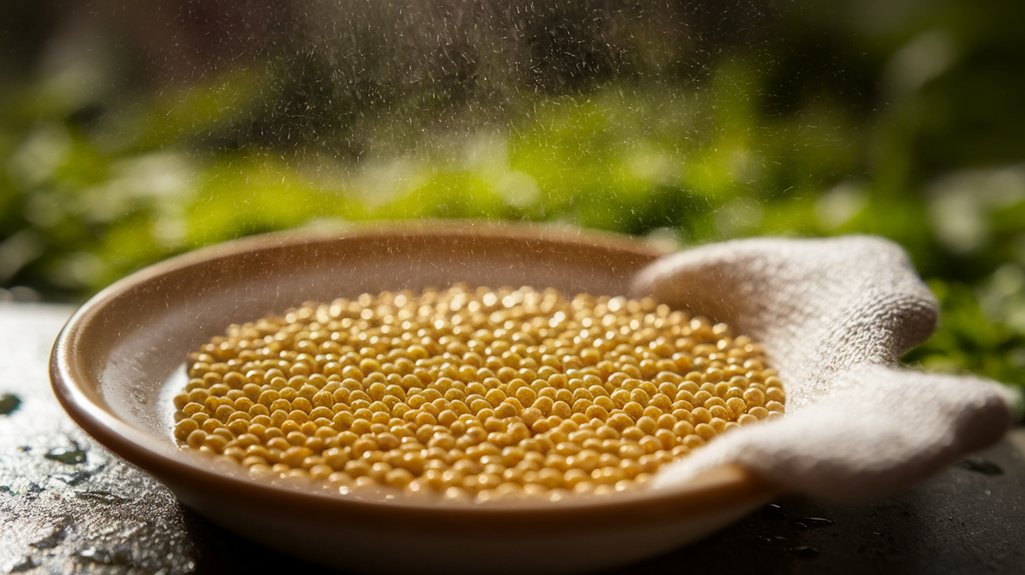
To successfully sprout yellow mustard, it’s crucial to create the right environment.
I’ll guide you through the ideal temperature and humidity levels, light exposure requirements, and essential soil and water needs.
Getting these conditions just right will set you up for a thriving crop.
Temperature and Humidity Levels
While sprouting yellow mustard seeds, I’ve found that maintaining the right temperature and humidity levels is crucial for successful growth. Ideally, the temperature should range between 65°F to 75°F (18°C to 24°C). This range encourages germination while preventing mold.
Humidity is just as important; I always aim for around 60-70% humidity to keep the seeds moist but not waterlogged.
Here are some key tips:
- Monitor temperature: Use a reliable thermometer to ensure consistent warmth.
- Control humidity: A humidity dome can help retain moisture without excess water.
- Ventilation: Ensure proper airflow to prevent mold growth while maintaining humidity.
Light Exposure Requirements
When it comes to sprouting yellow mustard seeds, light exposure plays a pivotal role in promoting healthy growth. I’ve found that these seeds thrive best in bright, indirect sunlight.
Too much direct sunlight can cause them to overheat or dry out, while insufficient light can stunt their growth. Ideally, I place my sprouting seeds near a window where they receive filtered light for about 12-16 hours a day.
If natural light isn’t available, I’ve successfully used grow lights set to a similar duration. It’s crucial to monitor their progress; you want the seedlings to develop a vibrant green color, indicating they’re getting enough light.
Soil and Water Needs
Achieving the right soil and water conditions is essential for successfully sprouting yellow mustard seeds. I’ve found that focusing on these key elements makes a significant difference:
- Soil Type: Use well-draining, loamy soil rich in organic matter. This helps retain moisture while preventing waterlogging.
- pH Level: Aim for a soil pH between 6.0 and 7.5. This range promotes optimal nutrient absorption and seed germination.
- Watering: Keep the soil consistently moist but not soggy. I usually mist the soil to maintain adequate humidity, especially during the germination phase.
Maintaining Your Mustard Sprouts
Maintaining your mustard sprouts is crucial for their growth and flavor. First, I ensure they receive adequate light—about 12-16 hours daily is ideal. If I’m growing them indoors, I use a grow light to supplement natural sunlight.
Next, I keep the soil consistently moist but not soggy; I check the top inch of soil daily and water as needed. Air circulation is also important, so I gently fan them or open a window to prevent mold.
I regularly check for pests, as they can quickly spread and damage my sprouts. Lastly, I thin out overcrowded sprouts to allow for proper spacing, which promotes healthy development.
Following these steps, my mustard sprouts thrive beautifully.
Harvesting Your Mustard Sprouts
It’s time to reap the rewards of your hard work and harvest your mustard sprouts! I always find this moment exhilarating—it’s when I finally get to enjoy the fruits of my labor.
Here’s how I do it:
- Timing: Wait until the sprouts are about 3-4 inches tall, usually around 7-14 days after germination.
- Technique: Use clean scissors to snip the sprouts just above the soil line, ensuring you avoid damaging the roots.
- Storage: Rinse the harvested sprouts gently and store them in a sealed container in the fridge, where they can last up to a week.
Harvesting is simple yet rewarding. Enjoy the vibrant flavor and freshness in your dishes, knowing you nurtured them from seed to sprout!
Nutritional Benefits of Yellow Mustard Sprouts
Yellow mustard sprouts pack a surprising nutritional punch that can elevate your meals. These tiny greens are rich in vitamins A, C, and K, promoting overall health and immunity. I love that they’re low in calories, making them an excellent choice for those watching their weight.
Their impressive fiber content aids digestion, while the presence of antioxidants helps combat oxidative stress.
Moreover, yellow mustard sprouts contain essential minerals like calcium, magnesium, and potassium, contributing to bone health and muscle function. The glucosinolates found in these sprouts may even support detoxification processes in the body.
Culinary Uses for Mustard Sprouts
Incorporating mustard sprouts into your culinary repertoire is an excellent way to enhance both flavor and nutrition. These tiny, vibrant greens pack a punch and can elevate a variety of dishes.
Here are a few of my favorite ways to use them:
- Salads: Toss them into fresh salads for a peppery kick that complements other greens.
- Sandwiches: Layer them in sandwiches or wraps for added crunch and zest.
- Stir-fries: Include them in stir-fries at the end of cooking for a burst of flavor without losing their crispness.
Using mustard sprouts not only boosts the nutritional value of your meals but also introduces an exciting flavor profile that can transform everyday dishes into something special.
Enjoy experimenting!
Troubleshooting Common Sprouting Issues
Sprouting mustard seeds can sometimes come with its own set of challenges, and I’ve encountered a few issues along the way.
One common problem is mold; if you notice white fuzz, it’s often due to excess moisture. I recommend rinsing your seeds thoroughly and ensuring they’re well-drained.
Another issue is slow germination, which can happen if the seeds aren’t kept in a warm, humid environment. I usually place mine in a location that’s around 70°F (21°C) to encourage growth.
If sprouts seem leggy, they might need more light; try moving them closer to a window or using a grow light.
Frequently Asked Questions
Conclusion
In conclusion, sprouting yellow mustard seeds is a rewarding and straightforward process that can enhance both your meals and your health. By following the steps outlined, you can enjoy fresh, nutrient-packed mustard sprouts right from your kitchen. Whether you toss them in salads or use them as a garnish, these sprouts offer a zesty flavor and a wealth of nutritional benefits. So, gather your seeds and get sprouting—you won’t regret it!
